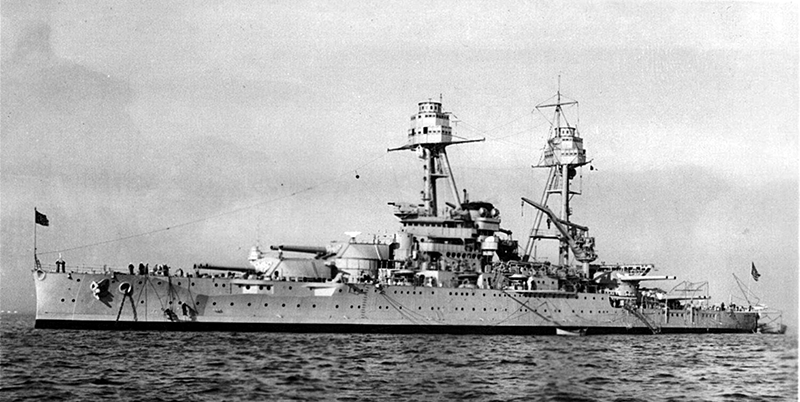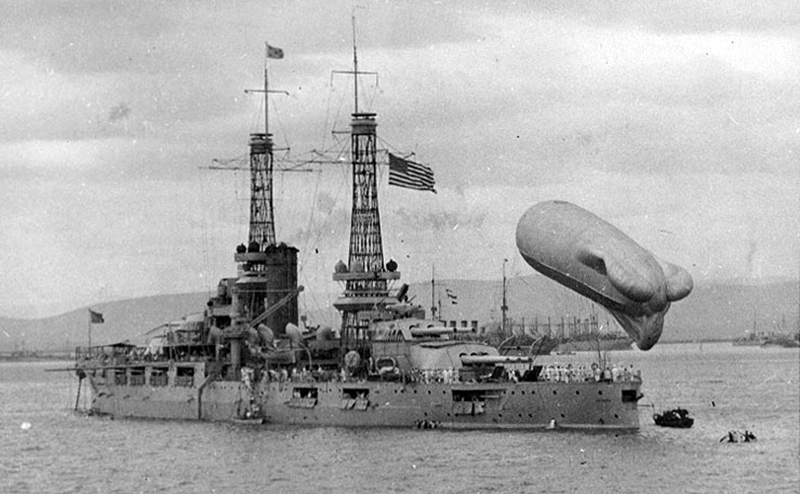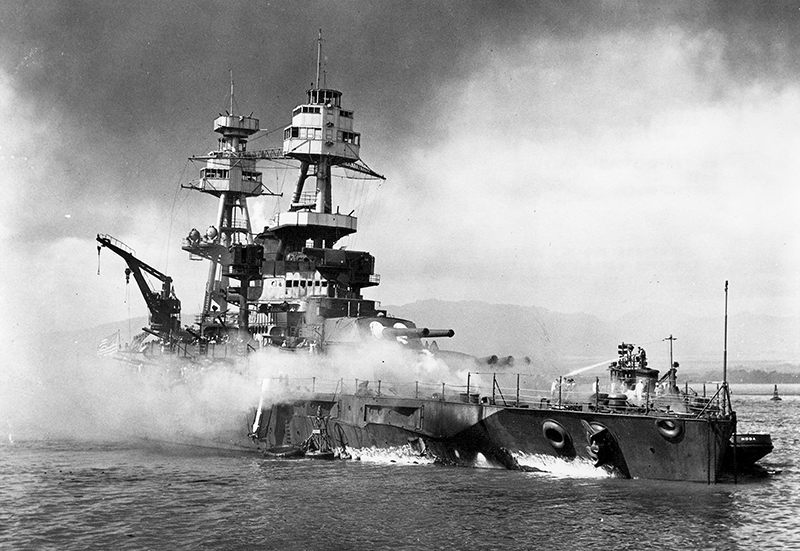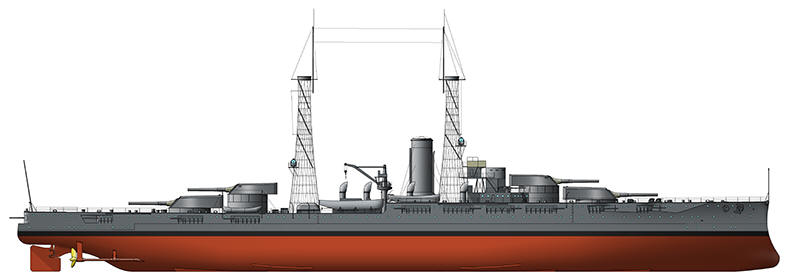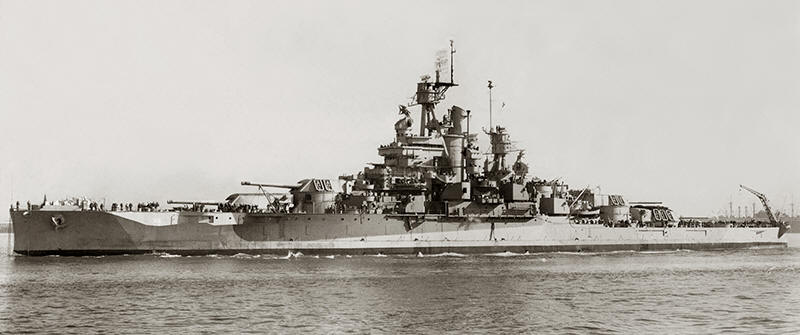
NAVYPEDIA
 Support the project with paypal
Support the project with paypal
Photo
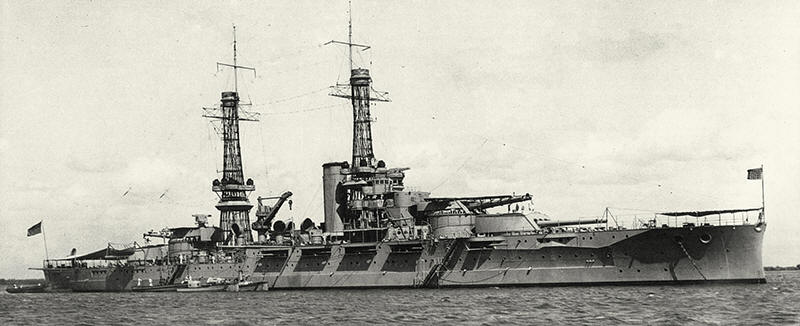
Oklahoma as built
Ships
| No | Name | Yard No | Builder | Laid down | Launched | Comm | Fate |
|---|---|---|---|---|---|---|---|
| BB36 | Nevada | 205 | Fore River, Quincy | 4.11.1912 | 11.7.1914 | 11.3.1916 | target for nuclear tests 2.1946 |
| BB37 | Oklahoma | 130 | New York SB, Camden | 26.10.1912 | 23.3.1914 | 2.5.1916 | sunk 7.12.1941 |
Technical data
| Data variant | as commissioned | 1929-1930 modernization |
|---|---|---|
| Displacement standard, t | --- | 29067 |
| Displacement normal, t | 27500 |
|
| Displacement full, t | 28400 |
31706 |
| Length, m | 175.3 wl 177.7 oa |
175.6 wl 177.7 oa |
| Breadth, m | 29.1 |
32.9 |
| Draught, m | 8.70 |
9.04 full load |
| No of shafts | 2 |
2 |
| Machinery | BB36: 2 Curtis steam turbines, 12 Yarrow boilers BB37: 2 VTE, 12 Babcock & Wilcox boilers |
BB36: 2 sets Parsons geared steam turbines, 6 Bureau Express boilers BB37: 2 VTE, 6 Bureau Express boilers |
| Power, h. p. | BB36: 26500 BB37: 24800 |
25000 |
| Max speed, kts | 20.5 |
20.5 |
| Fuel, t | oil 2030 |
oil 3148 (6274 max) |
| Endurance, nm(kts) | 5195(12) | 15700(10) |
| Armour, mm | belt: 343 - 203, bulkheads: 330 - 203, deck: 76, (63 aft), splinter deck: 51 - 25, barbettes: 330, turrets: 457 (triple) or 406 (twin) face, 254 - 229 sides, 127 crowns, 229 rear, CT: 406 sides, 203 roof |
belt: 343 - 203, bulkheads: 330 - 203, deck: 127, splinter deck: 51 - 25, barbettes: 330, turrets: 457 (triple) or 406 (twin) face, 229 sides, CT: 406 |
| Armament | 2 x 3 - 356/45 Mk I, 2 x 2 - 356/45 Mk I, 21 x 1 - 127/51 Mk VIII, 2 - 533 TT (beam) |
2 x 3 - 356/45 Mk 9, 2 x 2 - 356/45 Mk 9, 12 x 1 - 127/51 Mk 8, 8 x 1 - 127/25 Mk 10.11.13, 2 catapults, 3 seaplanes (OJ, O2U) |
| Complement | 864 |
1374 |
Standard scale images
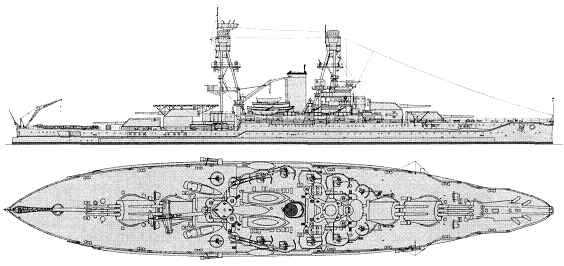
Oklahoma 1941

Nevada 1945

Oklahoma 1941
Graphics
Project history
This was a revolutionary design of 1912 programme, introducing 'all or nothing' protection. Since armour-piercing shells did not burst when penetrating thin plating, the designers reasoned that there was nothing to be gained from using thin armour which would serve only to detonate shells. Better to choose either the thickest armour, which would not be penetrated, or no armour at all; hence the name. The Nevadas were the first ships designed to General Board Characteristics (staff requirements), and they reflected the new demands of very long-range battle: heavy deck armour and highly centralized fire control.
In the previous New York class, the central fire control station had to be placed above the relatively thin protective deck, since all of the hull volume below that deck was occupied by machinery and magazines. It was, therefore, enclosed in light splinter armour. In theory, shells would strike the 'lower casemate' and burst before they could reach the 'central', and its thin armour would defeat the splinters. As expected battle ranges increased, however, shells might well pass over this upper bell, to strike the 'central' directly. The first step in the Nevada design, then, was to move the main armoured deck to the top of the upper belt, with a splinter deck placed below it to protect the machinery and magazines from shells bursting after penetrating the main armoured deck. It followed that the upper and lower belts might as well be merged into a single armour belt. Similarly, the upper casemate armour, which in earlier designs had protected the off-side secondary guns and the uptakes, was abandoned in favour of heavy casemate armour. Armour could also be used more efficiently, because the main battery was concentrated into four rather than five turrets.
At the same time, oil fuel was introduced, after tests in Delaware. Its advantages includes a reduction in the engine-room complement, and a consequent saving in berthing. However, there was no longer any coal protection to the machinery spaces, and a new form of underwater protection was required. In fact no truly satisfactory type of underwater protection was developed until 1915, in the Tennessee class.
These two ships were built with competitive powerplants, turbine in Nevada and recipropating in Oklahoma.
Ship protection
122m-long belt had 5.3m height and was 343mm thick at upper part tapering to 203mm at lower edge. Belt was connected with end barbettes by 320mm bulkheads. There was 2.6m in height 203mm belt at 18.3m length aft from aft bulkhead, protecting steering gear; it was closed aft by 229mm bulkhead. Flat main armour deck was connected with upper edge of belt and was 89mm over citadel. There was 38mm splinter deck with 51mm slopes one level lower , slopes were connected with lower edge of belt. This deck was 63mm thick aft from citadel, protecting steering gear. Main gun turrets had 457mm (triple) or 406mm (twin) faces, 254-229mm sides, 229mm rears and 127mm crowns. Barbettes were 330mm over and 114mm under main deck. CT had 406mm sides and 127mm roof. Underwater protection was 3.0m deep. There was 38mm longitudinal bulkhead.
Ship protection after modernization: 122m-long belt had 5.3m height and was 343mm thick at upper part tapering to 203mm at lower edge. Belt was connected with end barbettes by 320mm bulkheads. There was 2.6m in height 203mm belt at 18.3m length aft from aft bulkhead, protecting steering gear, it was closed aft by 229mm bulkhead. Flat main armour deck was connected with upper edge of belt and was 127mm over citadel. There was 38mm splinter deck with 76mm slopes one level lower, slopes were connected with lower edge of belt. This deck was 63mm thick aft from citadel, protecting steering gear. Main gun turrets had 457mm (triple) or 406mm (twin) faces, 254-229mm sides, 229mm rears and 127mm crowns. Barbettes were 330mm over and 114mm under main deck. CT had 406mm sides and 203mm roof. Underwater protection was 5.8m deep. There was 38mm longitudinal bulkhead.
Modernizations
1916, both: + 2 x 1 - 76/52 Mk X
1919 - 1920, both: + 6 x 1 - 76/52 Mk X
late 1922, both: + 1 catapult with 1 seaplane (MO or UO)
(8/1927 - 1.1930, Norfolk NYd) Nevada, (9/1927 - 7.1929, Philadelphia NYd) Oklahoma: were modernized as follows. New machinery and boilers were fitted, horizontal armour was strengthened, part of secondary guns was moved one deck up. Maximal main guns elevation angle was increased up to 30°.
1941, Oklahoma: + 4 x 1 - 76/50 Mk 20
(12/1941 - 10.1942), Nevada: - 12 x 1 - 127/51, 8 x 1 - 127/25, 1 catapult; + 8 x 2 - 127/38 Mk 12, 8 x 4 - 40/56 Mk 1.2, 16 x 1 - 20/70 Mk 4, SC, SG, Mk 3, 4x Mk 4 radars; full displacement was 35400 t
summer 1944, Nevada: + 1 x 4 - 40/56 Mk 1.2, 22 x 1 - 20/70 Mk 4
11/1944, Nevada: - 33 x 1 - 20/70; + 1 x 4 - 40/56 Mk 1.2, 20 x 2 - 20/70 Mk 4
1/1946, BB36 Nevada: 2 x 3 - 356/45 Mk 9, 2 x 2 - 356 Mk 9, 8 x 2 - 127/38 Mk 28, 10 x 4 - 40/60 Mk 2, 20 x 2 - 20/70 Mk 24, 5 x 1 - 20/70 Mk 10, 2 catapults, 3 seaplanes, SC, SG, Mk 3, 4x Mk 4 radars
Naval service
Oklahoma was sunk in Pearl Harbor by B5N2 bombers from Japanese carrier Akagi: she received 4 torpedoes, overturned and sunk. Later, 6.11.1943 wreck was salvaged and used till 1947 as hulk. Nevada 7.12.1941 was badly damaged during Japanese aircraft raid to Pearl Harbour; she received hits of one air torpedo and 2-3 bombs and ran aground. Nevada was salvaged 12.2.1942 and was under repair till March of 1943.
 HOME
HOME FIGHTING SHIPS OF THE WORLD
FIGHTING SHIPS OF THE WORLD UNITED STATES OF AMERICA
UNITED STATES OF AMERICA CAPITAL SHIPS AND MONITORS
CAPITAL SHIPS AND MONITORS NEVADA battleships (1916)
NEVADA battleships (1916)
